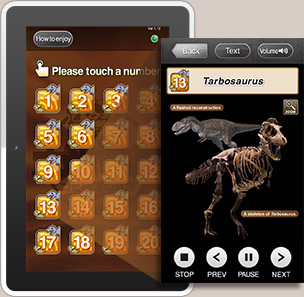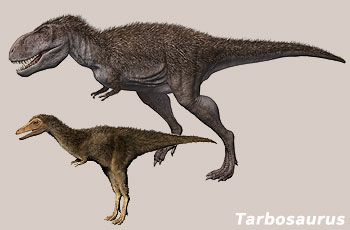 Special Exhibition
October26,2013 - February 23,2014
Special Exhibition
October26,2013 - February 23,2014
| Period | October26,2013 - February 23,2014 |
|---|---|
| Hours | 9:00 a.m. - 5:00 p.m. 9:00 a.m. - 8:00 p.m. (Every Friday) *Visitors are admitted until 30 minutes before closing time |
| Days closed | October 28 |
The opening schedule and other information might change depending on the situation. Please refer to our website for any further notice. |
|
| Adults and University student |
1,500 yen |
|---|---|
| Students of elementary junior high high school |
600 yen |
| Access |
Access to the National Museum of Nature and Science |
|---|
Multimedia Guide in English is now available!
| Rental fee | 500yen (tax included) |
|---|---|
| It takes about 25 minutes listening to 20 commentaries. | |

The Amazing Dinosaurs of the Gobi Desert exhibits more than 100 extremely well preserved fossils from Mongolia and 90% of the fossils are original! We have newly introduced a tablet PC based multimedia guide in English. The guide includes text commentaries, photographs, and audio guide in English. The commentaries were written by William Sinclair of Okinawa Catholic Primary School and Dr. Makoto Manabe of National Museum of Nature and Science, Japan. The audio guide was generated from the text by a computer software, AI Talk®, developed by AI Inc., and the audio guide was materialized as a joint project with the Center for the Promotion of Interdisciplinary Education and Research (CPIER), Kyoto University.

The National Museum of Nature and Science presents a special exhibition entitled as “Amazing Dinosaurs of the Gobi Desert”. This temporary exhibition features valuable dinosaur fossils unearthed from the Mongolian Gobi Desert that have contributed greatly to understanding dinosaur evolution and biology.
The Mongolian Gobi Desert became famous worldwide as one of the earth’s richest localities of dinosaur fossils, after numerous discoveries made by the team of the American scientists led by Roy Chapman Andrews between 1922 and 1930. Most of the fossils discovered in the Gobi are very well preserved, and to this day continue to fascinate researchers from around the world.
This exhibition almost entirely consists of extremely well preserved original fossils, including mounted skeletons of Asia’s biggest carnivorous dinosaur, Tarbosaurus, large herbivore, Saurolophus and massive Opisthocoelicaudia. A juvenile skeleton of Tarbosaurus on display represents the best juvenile specimen so far discovered in Tyrannosauridae. The latest research by Japanese scientists on the ontogeny and growth of tyrannosaurids based on this specimen is also presented.
It is our hope that many of the visitors enjoy the beauty of the specimens with their own eyes going through the vast collection of original fossils from the Gobi. May this exhibition be an exciting learning opportunity of the latest knowledge of dinosaur studies and also of on-going research activities in the Gobi Desert.
